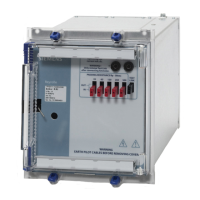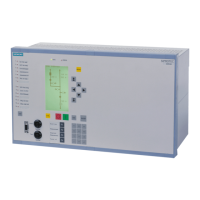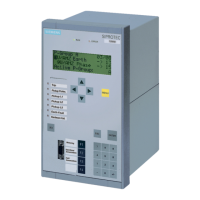This can be repeated for the reverse load settings for clarity if required. Increasing the 3 phase current angle in
the leading (positive) direction from forwards towards anti-phase (180 degrees) with respect to the 3 phase
voltage will pick up the Load Blinder REV signal when the angle from 180° equals the Angle +ve setting.
Increasing still further in the anticlockwise direction will approach the Reverse(-) boundary. The Load
Blinder REV signal will reset when the angle is above the Angle -ve setting plus 180° plus 3° hysteresis and
will pickup again when the angle is reduced to below 180° plus Angle -ve angle setting.
Table 9-1 Angle boundary
Load Blinder region Forward (+) Boundary Forward (-) Boundary
Angle = (Default=20°) Angle = (Default=20°)
PU (Raised) DO (Reset) PU (Raised) DO (Reset)
Angle
V
1
Setting
V
1
Setting can be checked by reducing balanced 3 phase voltage to below the setting with the low level
current as above, applied at zero degrees.
Table 9-2 V
1
Setting
Parameters Setting Operation
V
1
Setting 42 V
Determining Impedance Sensitivity
The impedance can be calculated directly from phase-neutral voltage divided by phase current.
Apply balanced 3 phase rated voltage and balanced 3 phase rated current. Calculate the current required to
achieve the relay impedance setting with nominal voltage. If this is possible without exceeding relay thermal
rating it can be injected manually. Increase the current until the Load Blinder FWD resets. If the current
required will exceed the continuous rating, short duration tests will be required at 90 % of impedance setting.
Alternatively, voltage can be reduced to allow lower current to be applied to achieve the required impedance
but the V
1
Setting must always be exceeded as this will otherwise block the operation.
Table 9-3
Trip Level
Parameters Setting DO PU
Impedance Ω
Voltage V 63.5
24 Overexcitation Protection
24 Overexcitation Protection
The V/f settings for these elements are scaled on the basis of multiple of nominal voltage and frequency.
Application of a voltage of nominal voltage and frequency represents 1.0.
Testing is simplified by applying nominal frequency and increasing voltage only, such that the operating level
is simply the setting multiplied by nominal voltage.
Definite Time (24DT-N)
If DTL setting is small, gradually increase voltage until element operates.
If DTL is large apply 0.95 times setting, check for no operation, apply 1.05 times setting, check operation.
Apply 0.9 times voltage, increase to 1.1 times setting and record operating time.
9.10.2
Functional Tests
9.10 Protection Functional Tests
422 Reyrolle 7SR5, Transformer Protection Device, Device Manual
C53000-G7040-C015-1, Edition 11.2019

